Summer is all about road trips and exploring the countryside. While you are excited about your 2023 adventures, you must be nervous to take your four-legged friend along to enjoy the journey. Whether you plan to travel by air or take your cat on a short trip by road, you must be aware of the do’s and don’ts of traveling with a cat.
While dogs are adaptable in terms of visiting new places and destinations, cats usually take much time setting up their territory and getting comfortable in new places. They are known for their marking behaviors and are typically found at the same site at various times of the day. Cats are known as creatures that are ruled by habits. They don’t like changes in their everyday routine, and new sounds, smells, and sights are a big change for them. But that doesn’t mean you cannot travel safely and peacefully with your furry friend.
Traveling with a cat is not as challenging as it seems. With the right preparation and care, you can make it a fun and memorable experience for your cat. In this article, we have jotted down all the information you may require if you have plans to travel with your cat and some tips and guidelines to help make it comfortable for the two of you.
Can I travel with my cat?
It is one of the most frequently asked questions by cat owners. Yes, your cat can travel with you. Many people travel more often with their cat, while some prefer to leave them behind with their friends and family or even in a nice cat boarding facility.
Read More: Common Health Issues in Cats: Symptoms, Risks and Preventive Care
While traveling with a cat, you must consider their temperament and comfort levels. Some cats stress out in unfamiliar settings, making it difficult for you to keep them calm and comfortable throughout the journey. If your cat has medical issues, consult your vet, especially if you plan to travel by air. Also, leave your cat with someone who can administer their medicines timely.
Proper planning and preparation are vital for traveling with a cat. If you are traveling by plane, look for airlines with pet travel policies. To meet the airline’s regulations, obtain proper documentation, such as a certified health certificate and a pet passport. If you plan to travel by car, secure your cat in a carrier to avoid injuries from abrupt stops and even accidents. Give them complete access to food, water and litter during the trip.
Traveling with a cat by air
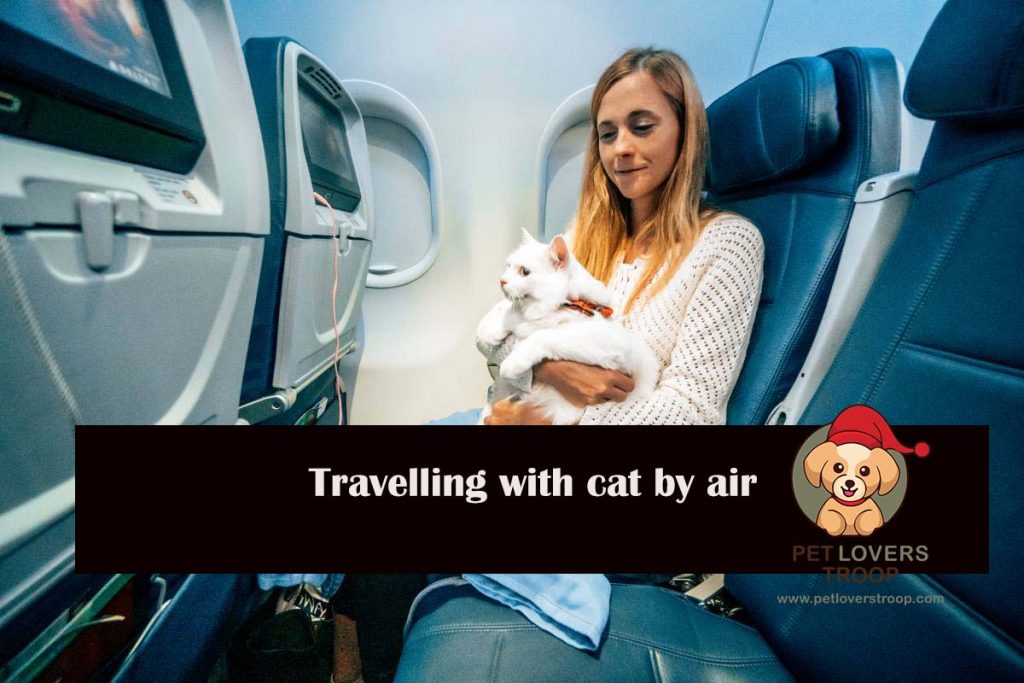
Flying with your cat can be a daunting experience. It would be best to start preparing your cat for traveling at least a month before the actual date. Some countries require extensive documentation and vaccines to avoid prospective health issues. USDA-certified VET completes all the traveling documents. However, it is advised to keep checking the latest information on the USDA website, as the policies are subject to change. Also, you can contact pet visa processing companies that charge a fee to help you with the documentation process.
Read More: The Right Tricks and Hacks to Deal with Cat Hairballs
On the day of traveling, if your cat exhibits signs of stress, such as excessive drooling or vocalization, it is best to leave them at home with a family member or friend or at a pet boarding facility. Here are some tips to make your journey safe and comfortable with your furry friend.
Pick the right airline
Not all airlines allow pets. Make sure you research well and opt for an airline that allows cats. Also, some airlines might require additional documentation, such as a health certificate or allow a certain breed of cats only. It is advised to go through all the policies and procedures in advance to avoid any inconvenience. Besides, some airlines have a limit on the total number of pets allowed in a cabin.
Each airline allows a different dimension of carrier and baggage limit. For instance, Alaskan Airlines allow 17 “L x 11 “W x 7.5 “H hard-carrier size dimensions, while American Airlines does not allow a cat exceeding 20 pounds. It is usually recommended to take non-stop flights to limit the travel time and stress for your feline.
Take along a carrier

You need to carry the right carrier size for your cat. Ensure it has enough room for them to turn or stand up. The carrier should be sturdy and well-ventilated; however, ensure that your cat is used to being carried in it. Place the carrier in the back seat, as the front seat is more prone to injuries resulting from airbags. Secure it with the help of the belt or bungee cords to avoid a sudden slide or fall. Place additional padding or a blanket in the carrier.
Do not leave food and water inside the carrier, as it can create a mess from spilling. You can give your cat food and water at regular intervals during the flight. Also, leave the harness on your cat and attach a leash whenever you open the carrier. Do not leave the leash inside, as your cat might get tangled.
Pack all the essentials
Thoroughly pack all the essentials that your cat might require during the flight, such as food, water, prescribed medications, litter, a leash or harness, paper towels and a first aid kit. It is also advised to carry their toys and a blanket to make them more comfortable. Feeding your cat in the morning before the flight is better to avoid nausea or vomiting.
Prepare your cat for the trip
Traveling with a cat requires weeks of training and planning ahead of time. Get your cat used to a harness and carrier. You can start by placing them in the carrier at home but leave it open so they can explore it in their own ways. Also, start with shorter periods and gradually increase the overall time. Offer them praises and treats, and once they get used to it, take them for one-minute drives. You can increase the drive timing and take it up to five minutes.
Introduce them to security check
Before boarding, your cat must go through the metal detector for a security check. Prepare your cat for this process in advance, as you must take them out to be scanned. Get them used to stranger’s touch, to avoid any inconvenience or discomfort. You can also put on a harness and leash to prevent them from getting away at the airport.
Carry a calming aid
Cats are usually prone to anxiety and stress, especially when exposed to new places. It is advised to keep a calming aid such as Pheromone spray or a Thundershirt. However, do make sure that you consult your vet before giving them any medication, as some calming aids can have adverse effects on cats.
Read More: Understanding Gastric Stasis in rabbits. How to treat a sick rabbit at home?
Sedatives and supplements can be good option for long trips. However, they carry their own set of risks. In fact, even airlines do not allow them, as they directly impact a cat’s ability to regulate its body temperature.
Is traveling with a cat by air costly?
Being a cat parent is a long-term commitment. Not only does it require looking after them and giving them lots of attention and care, but it also comes with financial obligations. Flying with a cat can be costly, as each airline has a different fee per flight and destination. For instance, Alaskan Airlines costs $100 per flight, while American Airlines costs $120. You will also be required to pay an additional amount for baggage, with can be around $20 to $40.
Traveling with a cat by car, bus or train?
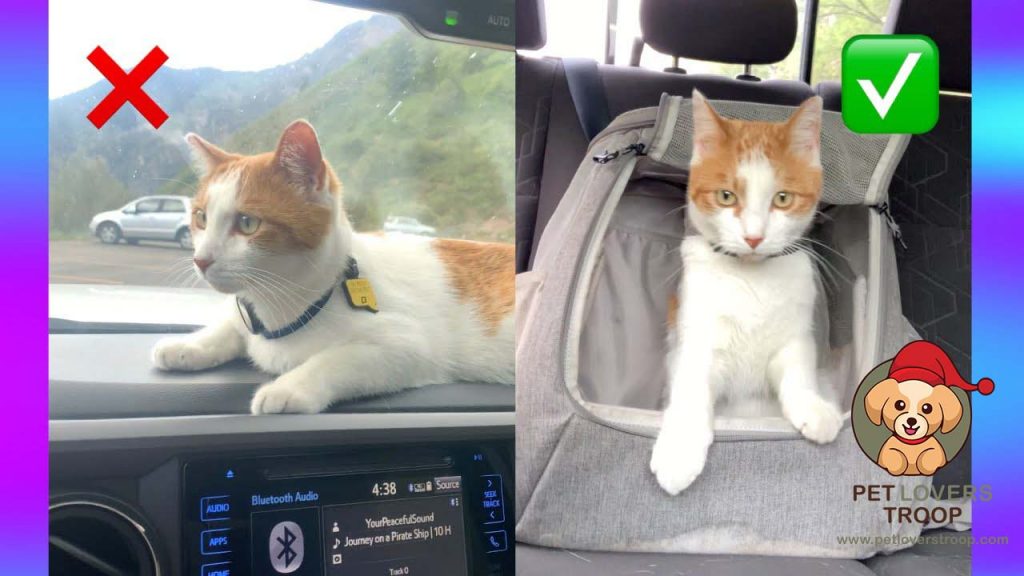
Traveling with a cat by car, bus, or train can be challenging, but with the right planning and preparation, you can manage it comfortably. Cats usually don’t like long distances and prefer to stay home in their comfort zone. If you like traveling by road, you should start traveling with your cat when they are just a kitten. Train them to sit in a carrier and make it a routine process for them. Here are some tips that can make your journey easier:
Make them used to traveling
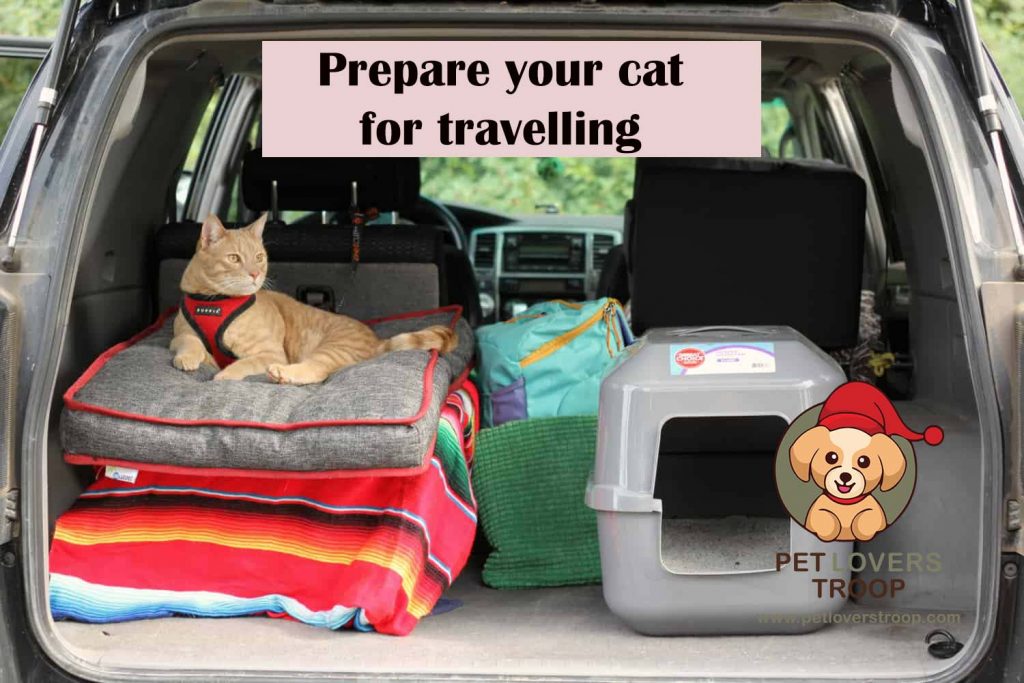
Cats are usually not used to traveling in cars, buses and trains. Ideally, start preparing your cat by taking them on short trips around your block. Start with a one-minute drive and take it to around 10 minutes. It will help your cat to get used to the motion and help them manage their stress and anxiety levels.
Invest in a good carrier
Choose the right carrier size for your cat, so they can comfortably move around in it. Teach them that it would be a usual hang-out place, but ensure the carrier is open and you are always around. Show them the entry and exit points and once the cat gets used to it, close it, walk around the house, and take them on short car drives. Remember to reward her for staying in the carrier. While traveling, make sure the carrier is securely fastened in the car. You can put on a seatbelt or place it in the back seat.
Carry all cat essentials
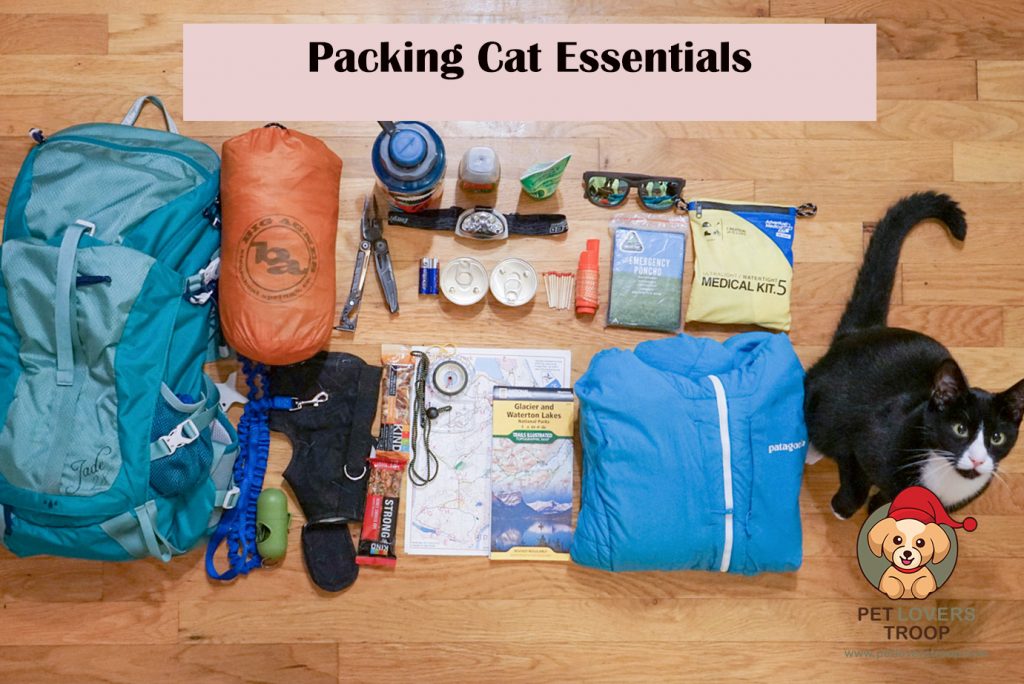
Pack wisely and ensure you keep everything your cat might require during the trip. Carry water, food, prescribed medications, toys, an extra blanket and litter. Remember to keep their medical documents, such as vaccination certificates. Also, pack your cat’s food in familiar individual food containers.
Read More: Dirty fish tank: How to maintain your fish tank’s hygiene and health?
Don’t forget to take extra water bottles, as some parts of the country have water with different mineral contents, which can possibly trouble your cat’s stomach.
Take frequent breaks
As mentioned earlier, cats do not like long distances, so try to take frequent breaks during the trip. Allow your cat to stretch their legs, breathe fresh air, and use their litter box. Also, only let your cat out with a leash or harness. If you are traveling with a cat by bus, try to sit in the front of the bus, away from the engine noises and vibrations. Try and talk to them during the trip to keep them relaxed and calm.
Should we use a cat travel tranquilizer?
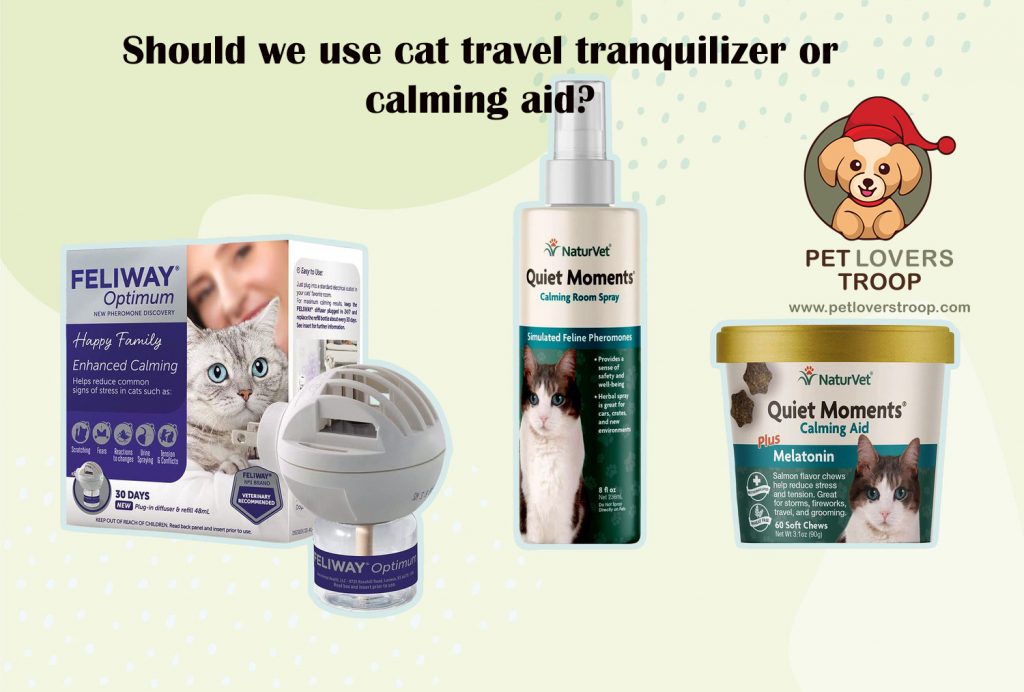
Travel tranquilizer or sedatives is a controversial topic. While some vets and animal welfare experts support their use to keep your cat calm during travel, most warn against the associated risks.
Read More: Should You Give Your Cat a Sedative for Traveling? Here’s What You Need to Know
Some common side effects may include lethargy, drowsiness, decreased blood pressure, loss of appetite, respiratory depression, allergic reactions, reduced coordination and, in rare cases, even death. Also, as mentioned earlier, airlines prohibit using sedatives for cats and other pets during air travel.
How to know your cat is uncomfortable while traveling?
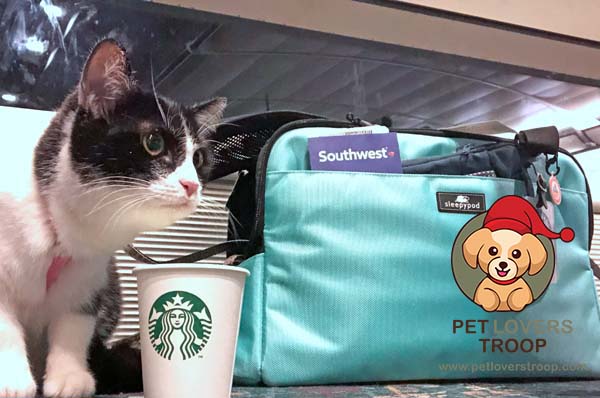
Cats are not that good travel partners, as compared to dogs. But with the right training and preparation, you can make them fond of traveling. Cats usually find it difficult to express themselves when uncomfortable, so being a cat pet, you must pay close attention to their body language or behavior to determine if they are stressed out. Here are some signs that you should look out for:
- Excessive meowing or vocalization
- Restlessness
- Cowering in the carrier
- Panting
- Drooling
- Avoiding or refusing to eat or drink
- Frequent urination in the carrier
If you notice any of these signs, your cat is stressed out. Try to talk to them soothingly and offer them treats and toys. Try and cover the carrier either with a towel or blanket. You can also use pheromone sprays or diffusers to calm your cat, but consult your vet first. Play soft and calming music at a low volume, as it will help to create a safe and comfortable environment for them.


